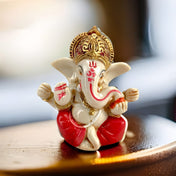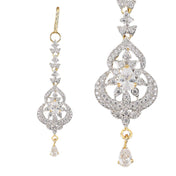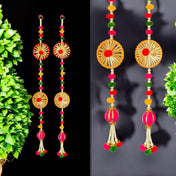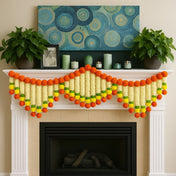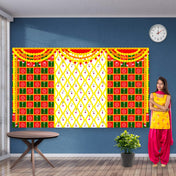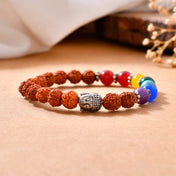Rangoli, a vibrant and intricate art form, has adorned Indian homes for centuries during festivals and special occasions. Today, DIY rangoli mats offer a fresh, modern twist on this beloved tradition by providing a reusable, washable alternative to the conventional powder-based designs. These mats capture the festive spirit while making cleanup easier and reducing waste—an ideal solution for eco-conscious celebrations.
Why consider DIY rangoli mats?
Reusable rangoli mats save time and effort without compromising on beauty.
Washable surfaces allow for multiple uses across different events.
Portable designs enable festive floor art in any space, indoors or outdoors.
This guide explores creative DIY Rangoli Mat Ideas, shares step-by-step crafting tips, and reveals ways to personalize your festive décor with these innovative traditional rangoli alternatives. Embrace a blend of heritage and convenience that transforms your celebrations with lasting charm.
Additionally, we will delve into the art of Rangoli, providing colorful tips and techniques for stunning designs. We will also explore some unique DIY decoration ideas using mango leaves and marigold flowers that can add a special touch to your Dussehra celebrations. Furthermore, we will provide insights on creating paper marigold flowers which can be used not only in rangoli but also in other festive decorations such as torans.
Understanding Rangoli Mats: A Blend of Tradition and Innovation
A Rangoli mat is more than just a decorative item; it is a vibrant cultural expression that is deeply connected to Indian festivals such as Diwali. Traditionally, rangoli involves creating intricate designs on the floor using colored powders, rice, or flower petals as a way to invite prosperity and positive energy into homes. This art form is cherished for its symbolism and the happiness it brings during celebrations.
The Evolution of Rangoli: From Tradition to Modernity
The transition from traditional rangoli to modern rangoli introduces DIY rangoli mats as a contemporary alternative that respects heritage while embracing practicality. These mats capture the essence of rangoli designs but offer reusable, washable surfaces that eliminate the mess associated with powder-based patterns. Their eco-friendliness aligns with growing environmental awareness, reducing waste without sacrificing festive spirit.
LoveNspire: Bridging Tradition and Innovation
LoveNspire stands out by seamlessly blending tradition and innovation within its ethnic product range. Known for transforming age-old craftsmanship into enduring treasures, LoveNspire offers beautifully crafted rangoli mats that reflect cultural authenticity and modern convenience. This brand embodies the spirit of cultural celebration through products that enrich home decor and honor Indian artistry in fresh, accessible ways.
More Ways to Celebrate with LoveNspire
Moreover, LoveNspire also offers a stunning collection of wooden rangoli products which provide a unique and traditional way to decorate homes for Diwali. Additionally, their candleholder collection adds a touch of elegance to Diwali decorations while embodying the essence of rangoli.
Benefits of Creating Your Own Reusable Rangoli Mats
Crafting your own reusable rangoli mats offers a compelling blend of eco-friendly festooning and practical design. Traditional rangoli often involves colored powders that, while beautiful, create waste and require meticulous cleanup. Choosing DIY mats reduces environmental impact by eliminating the need for single-use powders. These mats can be used repeatedly, supporting sustainable celebration practices that honor tradition without compromising the planet.
Advantages of reusable rangoli mats include:
- Environmental Responsibility: No powder residue or dust, which means less cleanup and reduced waste.
- Longevity: Durable materials ensure your festive floor art lasts through many celebrations.
- Cost-Effectiveness: One-time investment saves money over multiple uses compared to constantly purchasing raw powders.
- Portability: Lightweight and compact, these mats easily move between rooms or even venues, making them ideal for events beyond home settings.
- Ease of Maintenance: Washable surfaces and sturdy fabrics allow quick cleaning after use without damaging the intricate designs.
The concept of portable floor art transforms the way we decorate for festivals like Diwali. Instead of temporary creations made on bare floors, reusable mats bring convenience and versatility. They offer an opportunity to showcase creativity while honoring cultural heritage in a modern, responsible manner. This new approach supports both aesthetic appeal and ecological mindfulness, inviting families to celebrate with style and sensitivity.
Materials You Can Use to Make Stunning DIY Rangoli Mats
Creating vibrant and lasting rangoli mats begins with selecting the right craft supplies for DIY rangoli mat projects. A variety of materials can be repurposed or sourced affordably for a personalized touch that aligns with your festive spirit.
1. Old Clothes and Fabrics
Transform colorful sarees, dupattas, or even cotton shirts into fabric strips or patches. These provide rich textures and hues while promoting sustainability by upcycling unused textiles.
2. Cardboard
A sturdy base for your rangoli mat, cardboard can be cut into shapes or stencils. Look for free boxes from local stores or recycling centers to keep costs low.
3. Air-Dry Clay
Ideal for creating raised designs, air-dry clay allows for intricate patterns that add dimension. Craft stores and online marketplaces offer budget-friendly packs.
4. Wool Yarns
Soft, vibrant wool yarns are perfect for weaving patterns or outlining designs on mats. Thrift shops often carry yarn remnants at discounted prices.
5. Fabric Glue and Paints
Essential for assembling and decorating your mat, these supplies enable secure adherence and vivid coloring without messy powders.
Experimenting with combinations of these materials unlocks endless possibilities in your DIY Rangoli Mat Ideas. Local craft fairs, thrift stores, and online platforms like Etsy or Amazon provide excellent access to these resources without stretching the budget. Embracing diverse textures and colors brings both tradition and innovation to the floor art displayed during festive seasons.
Step-by-Step Guide: Crafting Your Own Beautiful Rangoli Mat
Creating a vibrant and unique rangoli mat brings the festive spirit right to your doorstep. This guide shows how to make a colorful mat using simple materials like fabric scraps and fabric glue, perfect for a quick yet stunning project.
Materials Needed:
- Fabric scraps in various bright colors
- A plain base fabric or old bedsheet
- Fabric glue or hot glue gun
- Scissors
- Pencil or chalk for sketching
Instructions:
- Prepare Your Base:
- Lay your base fabric flat on a clean surface. This will be the canvas for your rangoli mat design.
- Sketch Your Design:
- Using pencil or chalk, lightly draw a basic rangoli pattern—circles, flowers, or geometric shapes work well as starting points. If you're new to this art form, consider following this step-by-step guide with easy rangoli designs which provides helpful tips and techniques for beginners.
- Cut Fabric Shapes:
- From your colorful fabric scraps, cut out petals, leaves, dots, or any shapes matching your sketched design. Aim for sizes that fit proportionally within each section of your pattern.
- Arrange Before Gluing:
- Place the cut pieces on the base fabric following your sketch. Adjust colors and positions until satisfied with the look.
- Glue Pieces Securely:
- Apply fabric glue on the back of each piece and press firmly onto the base fabric. Allow drying time as directed by the glue manufacturer to ensure pieces stay put.
- Add Details (Optional):
- Enhance your mat with small beads, sequins, or embroidery stitches along edges for extra texture and sparkle.
This method combines creativity with practicality—your finished rangoli mat is washable and reusable, adding warmth and color to any festive setup without the mess of traditional powders. The flexibility of using fabric scraps also makes this project budget-friendly and environmentally conscious.
Personalizing Your Rangoli Mats: Adding Unique Touches
Customizing your DIY rangoli mats transforms them from simple decorations into meaningful expressions of personality and heritage. Incorporate elements that resonate with your family’s identity to create customized festive decor that truly stands out.
Ideas for personalization include:
- Family Initials: Use fabric paint, embroidery, or appliqué techniques to add your family’s initials at the center or corners of the mat. This subtle detail weaves a personal story into your design.
- Favorite Colors: Select colors that hold special significance or complement your home’s aesthetic. Vibrant hues can energize the space, while muted tones offer an elegant touch.
- Symbolic Motifs: Integrate motifs such as peacocks, lotus flowers, or diyas (lamps) to reflect cultural symbolism and bring auspiciousness to your decor.
- Mixed Textures: Combine materials like sequins, beads, or metallic threads with fabric scraps to add depth and tactile interest.
- Handwritten Messages: Write festive greetings or blessings using fabric markers as a heartfelt touch for guests.
Personalized mats become conversation starters, making every celebration warmer and more intimate. This blend of tradition with individual flair enhances the spirit of festivities while honoring timeless artistry.
Caring For Your Handmade Rangoli Mats: Maintenance Tips
Proper cleaning reusable floor art ensures your DIY rangoli mats remain vibrant and durable for many festive seasons. Different materials require tailored care to preserve their intricate designs:
- Fabric-based mats: Gently hand wash with mild detergent in cold water. Avoid harsh scrubbing to protect delicate patterns. Air dry flat to prevent warping or shrinking.
- Cardboard or paper mats: Use a soft, dry brush or cloth to remove dust. Keep away from moisture to avoid damage and distortion.
- Air-dry clay elements: Wipe with a damp cloth if needed; avoid soaking. Store in a dry place to prevent mold or crumbling.
- Wool yarn accents: Spot clean with a fabric-safe cleaner and dab gently. Prevent pilling by handling with care.
Storing your rangoli mats rolled or flat in breathable bags protects them from dust and moisture while maintaining their shape. Regular light cleaning keeps colors fresh and designs sharp, extending the life of your creative work.
These tips complement DIY Rangoli Mat Ideas, making your festive floor art not only stunning but also long-lasting and easy to maintain.
Using Your DIY Rangoli Mats To Elevate Festive Home Decor
Strategically placing your DIY rangoli mats brings vibrant energy to your home during Diwali celebrations. Consider these Diwali decoration ideas to maximize visual appeal:
- Entrance Areas: Position mats at doorsteps and foyer entrances to warmly welcome guests with traditional charm.
- Living Room Corners: Highlight cozy spaces by layering mats under small tables or near seating arrangements, creating inviting ethnic accents.
- Under Diyas and Lanterns: Use mats as colorful bases for oil lamps or lanterns, enhancing their glow and safeguarding surfaces.
- Dining Spaces: Brighten dining tables or buffet areas by incorporating smaller mats as placemats or centerpiece highlights.
Experiment with sizes and patterns from your collection of DIY Rangoli Mat Ideas to complement your room’s color palette. Mixing classic motifs with personal touches—like family initials or favorite hues—adds unique vibrancy.
These reusable mats not only celebrate tradition but also transform everyday spaces into festive showcases that reflect your cultural pride beautifully. You can even elevate your Diwali decor with flower rangoli, adding a creative touch with marigold flowers that align with the joyous spirit of the festival. Moreover, incorporating floral elements in your decoration can enhance the overall aesthetic, as explored in this article about the role of flowers for floral Diwali decoration.










